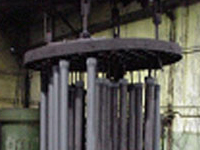Annealing / Protective Atmosphere Normalizing / Spheroidize Annealing
(click on thumbnail to enlarge)
| 1.) Load of torsion bars, manufactured from 4340 steel, normalized in the vertical position to maintain straightness. Parts measure approximately 3" in diameter by 6' long. |

Annealing / Protective Atmosphere Normalizing / Spheroidize Annealing |
| |
| 2.) 26,000 pounds of low carbon steel flat wire being prepared for spheroidize annealing. Spheroidize annealing is an intermediate processing step to allow the wire to be further rolled to a smaller gage without cracking. |

Annealing / Protective Atmosphere Normalizing / Spheroidize Annealing |
Annealing | Protective Atmosphere Normalizing | Spheroidize Annealing | Facilities

Annealing
Annealing is used to induce softness, to alter ductility, toughness, electric, magnetic or mechanical properties; or to produce a definite microstructure.
Steel is annealed by heating the steel to a temperature above the upper critical temperature, holding it there until the temperature is uniform throughout the part, and then slow cooling the part through the transformation range. The heating and cooling rates depend on the composition, shape and size of the part.
Full annealing removes the internal stresses, which build up as a result of cold working and other fabrication processes.
Protective Atmosphere Normalizing
The process of heating steels to the suitable temperature according to the kind of steels, followed by still-air cooling to remove the thermal influence of forging or hot rolling.
This treatment refines the grain size and enhances the uniformity of the microstructure. In some instances, this treatment will improve machinability.
A previously cold worked part will soften when normalized. An annealed part will harden when normalized.
Normalizing involves heating the steel to about 100°F above its upper critical temperature, generally 1650°F. The component is then held at this temperature until the temperature is uniform throughout the part (generally one hour per inch of thickness), and then cooled in air.
The microstructure produced by normalizing, depending upon the carbon content of the steel, is pearlite (eutectoid), pearlite in a ferrite matrix (hypoeutectoid), or pearlite in a commentate matrix (hypereutectoid). Cooling in air results in a fine pearlite with improved mechanical properties compared to the full annealing process described above.
Normalizing is used to refine the grain structure and to create a more homogeneous structure when a steel is to be reheated for hardening and quenching or full annealing, or to unify the microstructure of the heat effected zone of weldments, segregation in castings and forgings and provide a more uniform structure, and also to provide moderate hardening.
Spheroidize Annealing
Spheroidize annealing is applicable to steels which have more than 0.8% carbon. Parts are heated to between 1150°F and 1200°F and holding it at this temperature for a period of time to convert the microstructure. Essentially, cementite changes from a lamella formation to an alpha ferrite matrix with particles of spheroidal cementite (Fe3C). Spherodize annealing is generally done on parts which have been work hardened, to allow them to be further worked, either rolled in the case of coils, or drawn for wire. This resulting product has improved ductility and toughness with reduced hardness and strength. Spherodize annealing is normally carried out under a protective (endothermic) atmosphere to prevent oxidation and decarburization.
Facilities
Protective Atmosphere Hardening, Annealing, and Normalizing up to 2200°F
Maximum Load Sizes
- Pit Furnace - 180" Diameter x 96" High
- Pit Furnace - 36" Diameter x 60" High
- Pit Furnace (2) - 54" Diameter x 180" High
- Bell Furnaces (4) - 72" Diameter x 84" High
- Integral Oil Quench Furnaces - 24" x 36" x 24" High, 18" x 24" x 18" High
|
- Car Bottom - 78" Wide by 78" High x 192" Long
- Rotary Hearth Furnace and Press Quench - Up to 16" Diameter Parts
- Vacuum Furnace - 24" O.D. x 24" Deep
|

back to top |






 Print This Page
Print This Page


